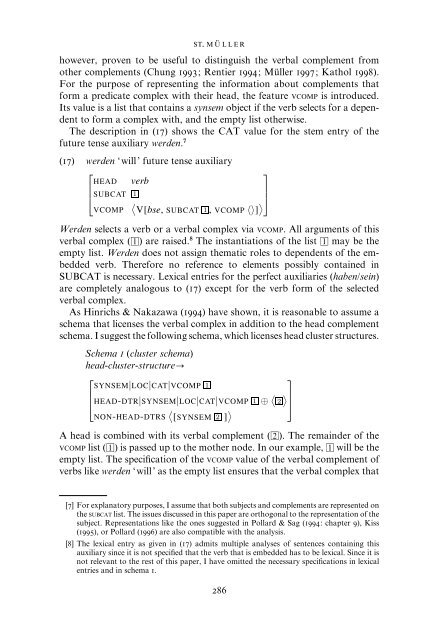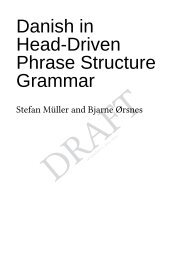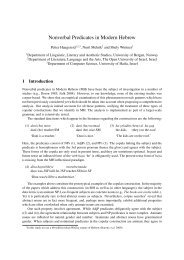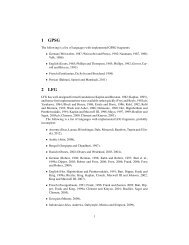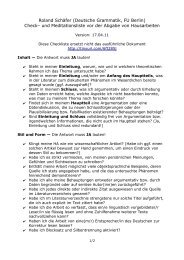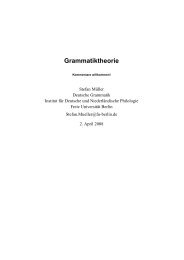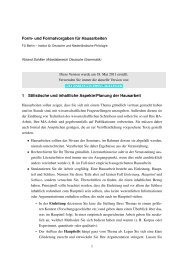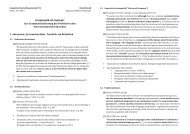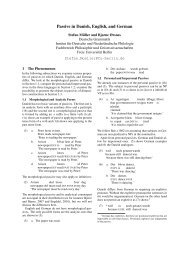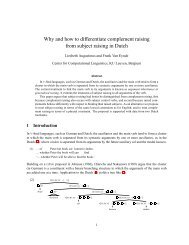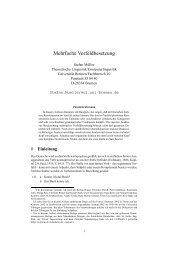Solving the bracketing paradox - German Grammar Group FU Berlin
Solving the bracketing paradox - German Grammar Group FU Berlin
Solving the bracketing paradox - German Grammar Group FU Berlin
Create successful ePaper yourself
Turn your PDF publications into a flip-book with our unique Google optimized e-Paper software.
ST. MÜLLER<br />
however, proven to be useful to distinguish <strong>the</strong> verbal complement from<br />
o<strong>the</strong>r complements (Chung 1993; Rentier 1994; Müller 1997; Kathol 1998).<br />
For <strong>the</strong> purpose of representing <strong>the</strong> information about complements that<br />
form a predicate complex with <strong>the</strong>ir head, <strong>the</strong> feature VCOMP is introduced.<br />
Its value is a list that contains a synsem object if <strong>the</strong> verb selects for a dependent<br />
to form a complex with, and <strong>the</strong> empty list o<strong>the</strong>rwise.<br />
The description in (17) shows <strong>the</strong> CAT value for <strong>the</strong> stem entry of <strong>the</strong><br />
future tense auxiliary werden. 7<br />
(17) werden ‘will’ future tense auxiliary<br />
⎡<br />
⎤<br />
HEAD verb<br />
⎢<br />
⎥<br />
⎣SUBCAT 1<br />
⎦<br />
〈 〉<br />
VCOMP V[bse, SUBCAT 1 , VCOMP 〈〉]<br />
Werden selects a verb or a verbal complex via VCOMP. All arguments of this<br />
verbal complex (1) are raised. 8 The instantiations of <strong>the</strong> list 1 may be <strong>the</strong><br />
empty list. Werden does not assign <strong>the</strong>matic roles to dependents of <strong>the</strong> embedded<br />
verb. Therefore no reference to elements possibly contained in<br />
SUBCAT is necessary. Lexical entries for <strong>the</strong> perfect auxiliaries (haben/sein)<br />
are completely analogous to (17) except for <strong>the</strong> verb form of <strong>the</strong> selected<br />
verbal complex.<br />
As Hinrichs & Nakazawa (1994) have shown, it is reasonable to assume a<br />
schema that licenses <strong>the</strong> verbal complex in addition to <strong>the</strong> head complement<br />
schema. I suggest <strong>the</strong> following schema, which licenses head cluster structures.<br />
Schema 1 (cluster schema)<br />
head-cluster-structurep<br />
⎡<br />
⎤<br />
SYNSEM|LOC|CAT|VCOMP 1<br />
⎢<br />
⎣HEAD-DTR|SYNSEM|LOC|CAT|VCOMP 1 ⊕ 〈 〉 ⎥<br />
2 ⎦<br />
〈 〉<br />
NON-HEAD-DTRS [SYNSEM 2 ]<br />
A head is combined with its verbal complement (2). The remainder of <strong>the</strong><br />
VCOMP list (1) is passed up to <strong>the</strong> mo<strong>the</strong>r node. In our example, 1 will be <strong>the</strong><br />
empty list. The specification of <strong>the</strong> VCOMP value of <strong>the</strong> verbal complement of<br />
verbs like werden ‘will’ as <strong>the</strong> empty list ensures that <strong>the</strong> verbal complex that<br />
[7] For explanatory purposes, I assume that both subjects and complements are represented on<br />
<strong>the</strong> SUBCAT list. The issues discussed in this paper are orthogonal to <strong>the</strong> representation of <strong>the</strong><br />
subject. Representations like <strong>the</strong> ones suggested in Pollard & Sag (1994: chapter 9), Kiss<br />
(1995), or Pollard (1996) are also compatible with <strong>the</strong> analysis.<br />
[8] The lexical entry as given in (17) admits multiple analyses of sentences containing this<br />
auxiliary since it is not specified that <strong>the</strong> verb that is embedded has to be lexical. Since it is<br />
not relevant to <strong>the</strong> rest of this paper, I have omitted <strong>the</strong> necessary specifications in lexical<br />
entries and in schema 1.<br />
286


